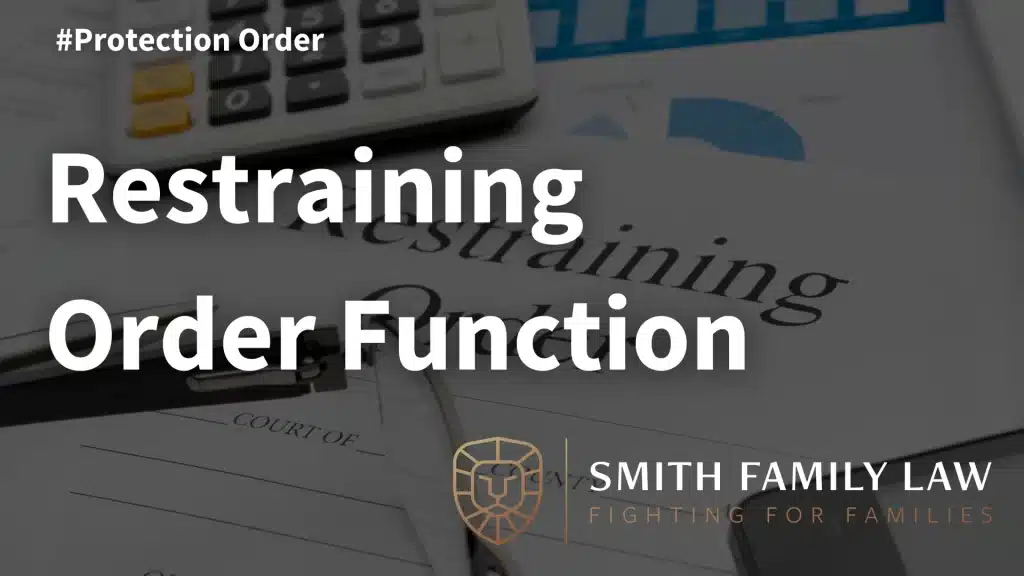When you find yourself threatened, harassed, or abused, it can be a frightening and overwhelming experience. You may feel helpless and unsure of where to turn for help. In such cases, a restraining order can provide a crucial layer of protection and peace of mind. Remember, you are not alone. Don’t know how does a restraining order work? The experienced and compassionate attorneys at Smith & Bledsoe Family Law are available to help you through this difficult time.
How Does A Restraining Order Work?
A restraining order, also known as a protective order, is a court-issued legal document that prohibits an individual from engaging in certain behaviors or coming within a specified distance of the person who requested the order. Restraining orders aim to protect victims of abuse, harassment, stalking, or threats of violence.
A restraining order works by legally prohibiting the person named in the order (the respondent) from engaging in specific behaviors, such as:
- Contacting the person who requested the order (the petitioner) in person, by phone, email, or through third parties
- Coming within a specified distance of the petitioner’s home, workplace, or school
- Possessing firearms or other weapons
- Engaging in abusive, threatening, or harassing behavior toward the petitioner
If the respondent violates the terms of the restraining order, they can face serious legal consequences, including fines, jail time, and a criminal record.
Types of Restraining Orders
There are several types of protective orders, including:
- Emergency protective orders: These short-term orders are issued by law enforcement when there is an immediate threat of harm. They typically last for a few days until the court can hold a.
- Temporary restraining orders: These orders are issued by a judge and remain in effect until a formal hearing can be held. Temporary ex parte protective orders are usually held within a few weeks.
- Permanent restraining orders: These long-term orders are issued after a formal hearing and can last several years or indefinitely, depending on the circumstances.
To obtain a restraining order, the petitioner must file a request with the court and provide evidence of the abuse, harassment, or threat of harm. This may include police reports, medical records, witness statements, or other documentation.
Once you file the request, a judge will review the evidence and decide whether to issue a temporary restraining order. If granted, the temporary order will remain in effect until a formal hearing is held. At this point, the judge will hear from both parties and decide whether to issue a permanent restraining order.
Can I File a Restraining Order Online?
The process for obtaining a restraining order varies by state and jurisdiction. You can request a restraining order online or through email in some areas. However, check with your local court or an experienced attorney to determine your area’s specific requirements and procedures.
Even if you can file a request online, you still need to appear in court for a formal hearing before the issuance of a permanent restraining order. This hearing allows both parties to present evidence and testimony, and it allows the judge to ask questions and make a final determination.
Can You Get a Restraining Order for No Reason?
No, you cannot obtain a restraining order without a valid reason. Restraining orders are legal documents a court issues to protect individuals from harm or abuse. To obtain a restraining order, you must demonstrate to the court that you have a legitimate fear of harm or have been the victim of abuse, harassment, or stalking.
Falsely obtaining a restraining order or using one as a means of harassment or retaliation is illegal and can result in serious legal consequences. Restraining orders should not be used frivolously or for minor disagreements.
What Are the Requirements for a Restraining Order?

- A relationship with the respondent: Most states require that the petitioner have a specific relationship with the respondent. For example, this includes relationships such as a current or former spouse, dating partner, family member, or household member. If a dating partner with prior incidents of abuse commits dating violence, they may be liable for any physical injury you incur.
- A legitimate threat of harm: The petitioner must show that the respondent has engaged in abusive, threatening, or harassing behavior that places the petitioner in fear of harm.
- Evidence of the abuse or threat: The petitioner must provide evidence to support their claim of abuse or threat of harm. This may include police reports, medical records, photographs, witness statements, or other documentation.
- A willingness to testify: The petitioner must testify in court about the abuse or threat of harm and provide evidence to support their claims.
Though some states allow individuals to file independently, seek the guidance of an experienced attorney to ease the legal process and protect your rights.
Seek Help and Support
Don’t know how does a restraining order work? If you are experiencing abuse, harassment, or threats of violence, seek help and support as soon as possible. A restraining order can provide a critical layer of protection but is not a substitute for a comprehensive safety plan.
In addition, consider reaching out to local domestic violence organizations or victim advocacy groups for additional support and resources. These organizations can provide counseling, shelter, and other services to help you stay safe and rebuild your life.
At Smith & Bledsoe Family Law, we understand the fear and uncertainty that come with experiencing abuse or harassment. Our experienced Austin restraining order attorneys can help navigate the legal process and obtain the protection you need to move forward.
If you are considering a restraining order or have questions about your legal options, don’t hesitate to contact our law firm. Call (512) 277-3166 or fill out our online form to schedule a confidential consultation with one of our skilled attorneys. We’ll listen to your story, explain your rights, and work tirelessly to obtain the protection and peace of mind you deserve.
Remember, you are not alone and do not have to suffer in silence. With the right legal guidance and support, you can regain control of your life and build a safer, more secure future.
